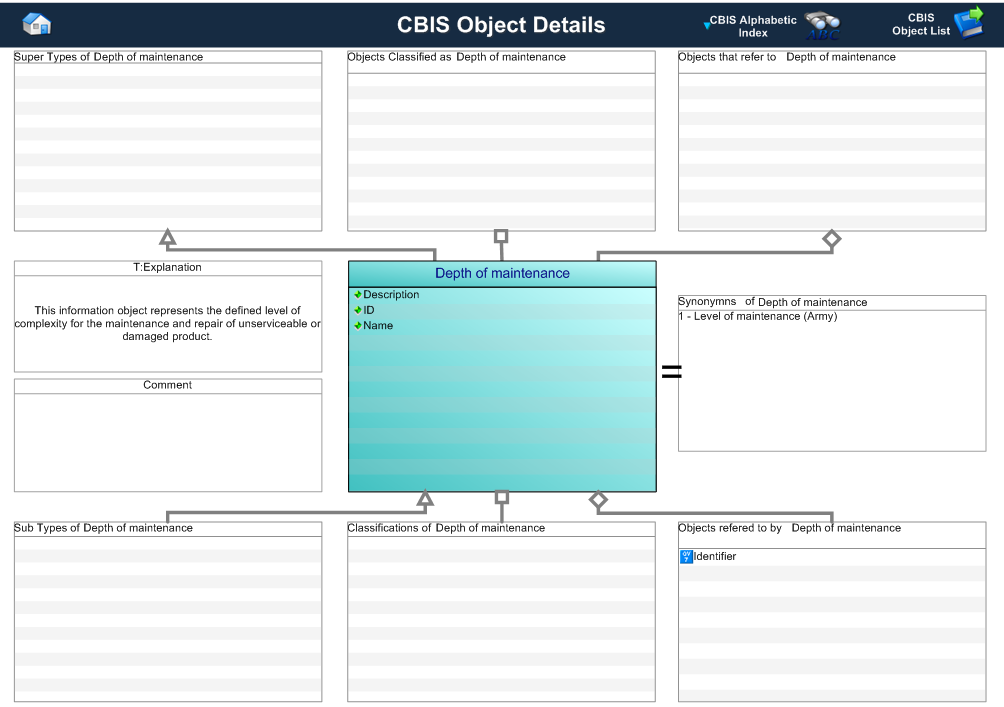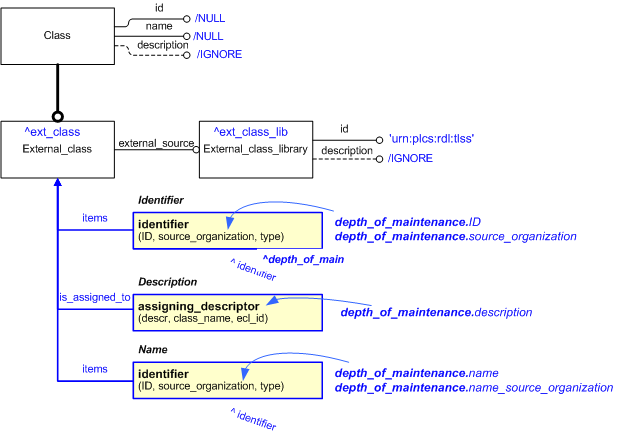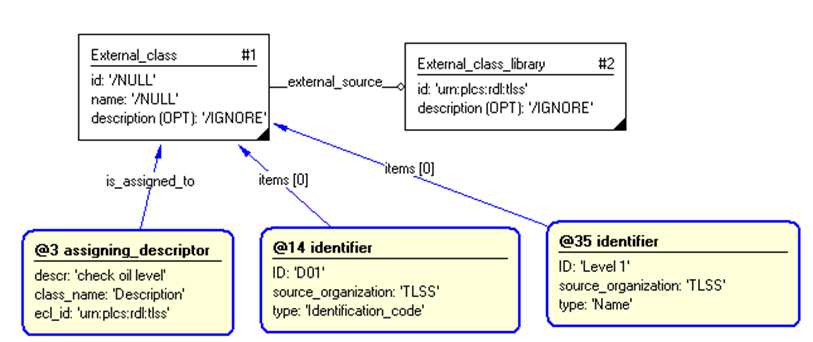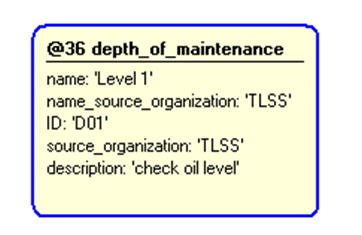Template:— depth_of_maintenance (dep_of_main)
Context:— UK_Defence |
Date: 2009/04/17 11:08:59
Revision: 1.2
|
This section specifies the template depth_of_maintenance.
NOTE
The template has been defined in the context of
UK_Defence.
Refer to the business context for details of related templates.
NOTE
An explanation of a template and the associated instantiation path is
provided in the
Template overview
section.
This template describes how to represent a UK_Defence depth of maintenance, using
Class.
This represents the defined level of complexity for the maintenance and repair of unserviceable
or damaged product.
For further information about the representation of a depth of maintenance, see below.
The depth of maintenance business object is used by those UK_Defence Data Exchange
Specifications that require information about the defined level of complexity for the
rectification of a damaged or unserviceable product.
Figure 1 — Graphical Representation for Business Object depth of maintenance
The definition of a depth of maintenance object is:
Data about the defined level of complexity for the maintenance and repair of unserviceable
or damaged product.
|
Attribute name
|
Attribute description
|
Attribute type
|
Optionality
|
| Description |
This is the description of the depth of maintenance |
Intrinsic |
Mandatory |
| ID |
This is the identifier of the depth of maintenance. |
Identifier |
Mandatory |
| Name |
This is the name of the depth of maintenance.
Examples (from DEF STAN 00-41/3):
(a) Level 1. Servicing and day to day preparation. It may include such
operations as functional testing, replenishment, servicing, re-arming, role
changing, minor modification, fault diagnosis and corrective maintenance by
replacement, adjustment or minor repair.
(b) Level 2. Corrective maintenance by replacement, adjustment or minor
repair including fault diagnosis and minor authorized modifications, within
specified times using generally provisioned resources.
(c) Level 3. Corrective maintenance in greater depth than Level 2. It
may include such operations as repair, partial reconditioning and
modification requiring special skills, special equipment or a relatively
infrequently used capability which is not economic to provide generally;
but which is short of complete strip, reconditioning and re-assembly.
(d) Level 4. That maintenance which is full reconditioning, major
conversions, or major repairs.
(e) Exception.
The Army, other than for aircraft, has different terminology and definitions of such levels:
(i) User maintenance: servicing and day to day preparation.
(ii) Unit repairs: minor corrective maintenance by replacement,
adjustment or minor repair including fault diagnosis and minor
authorized modifications, within specified times and normally using
First Line engineering support unit resources.
(iii) Field repairs: corrective maintenance in greater depth than
unit repairs, normally using resources of a Second Line engineering
support unit.
(iv) Base repairs: maintenance to base inspection standard in
greater depth than field repairs, normally using resources held by a
Third Line engineering support unit.
|
Intrinsic |
Mandatory |
Table 1 — depth of maintenance attribute details
The EXPRESS-G diagram in
Figure
2
shows the templates and EXPRESS entities that are required
to represent the template
"depth_of_maintenance".
The text highlighted in blue shows the template parameters.
Figure 2 — An EXPRESS-G representation of the Information model for depth_of_maintenance
The graphic for the template to be used in other EXPRESS-G diagrams
is shown in Figure
3
below.
Figure 3 — The graphical representation of the depth_of_maintenance template
The following input parameters are defined for this template:
The name of the depth of maintenance
The identifier of the organization responsible for the name of the depth of maintenance.
The identifier of the depth of maintenance.
The identifier of the organization responsible for identifying the depth of maintenance.
The description of the depth of maintenance.
The following reference parameters are defined for this template:
%^target = $depth_of_maintenance.depth_of_main%
Allow the
External_class
entity instantiated in this path to be referenced when this template is used.
Note: The
External_class
entity can be referenced in a template path by:
%^target = $depth_of_maintenance.ext_class%
Allow the
External_class_library
entity instantiated in this path to be referenced when this template is used.
%^target = $depth_of_maintenance.ext_class_lib%
The following parameter combinations specify a uniqueness constraint:
Unique constraint: Unique depth of maintenance
Each instance of the
entity
(
Identification_assignment)
within the data set shall be uniquely identified
by the following parameters on this
template (depth_of_maintenance) namely:
ID.
The
instance is
referenced by the following template parameter:
depth_of_main.
Any given identifier shall only be assigned to a depth of maintenance once.
The instantiation path shown below specifies the entities that are to be
instantiated by the template.
A description of templates and the syntax for the instantiation path is
provided in the
Templates Help/Information section.
External_class-- Mark the External_class entity as referable when this template is used. -- In other words, bind the External_class instance to the reference -- parameter ext_class %^ext_class =
External_class%
External_class.id = '/NULL'
External_class.description = '/IGNORE'
External_class.name = '/NULL'
-- Mark the External_class_library entity as referable when this template is used. -- In other words, bind the External_class_library instance to the reference -- parameter ext_class_lib %^ext_class_lib =
External_class_library%
External_class.external_source ->
External_class_libraryExternal_class_library.id = 'urn:plcs:rdl:uk_defence'
External_class_library.description = '/IGNORE'
/
identifier(
ID=@ID,
source_organization=@source_organization,
type='Identification_code',
items=^ext_class)/
%^depth_of_main = $identifier.identifier%
/
identifier(
ID=@name,
source_organization=@name_source_organization,
type='Name',
items=^ext_class)/
/
assigning_descriptor(
descr=@description,
class_name='Description',
ecl_id='urn:plcs:rdl:uk_defence',
is_assigned_to=^ext_class)/
The following entities are instantiated with attributes as specified:
The instance diagram in Figure
4
shows an example of the EXPRESS entities and templates that are instantiated by the template:
/depth_of_maintenance(ID='D01', source_organization='UK_Defence', name='Level 1', name_source_organization='UK_Defence', description='check oil level')/
(an illustration of the consolidated depth_of_maintenance template is shown in
Figure
5 below.)
Figure 4 — Entities instantiated by depth_of_maintenance template
The instance diagram in
Figure
5
shows the graphic symbol for the template that is to be
used in other instance diagrams. The example template is:
/depth_of_maintenance(ID='D01', source_organization='UK_Defence', name='Level 1', name_source_organization='UK_Defence', description='check oil level')/
Figure 5 — Instantiation of depth_of_maintenance template
Characterizations
No common characterizations of the template
depth_of_maintenance
have been identified. However, the ISO 10303-239 EXPRESS model
may enable other assignments to the entities instantiated by the template.




